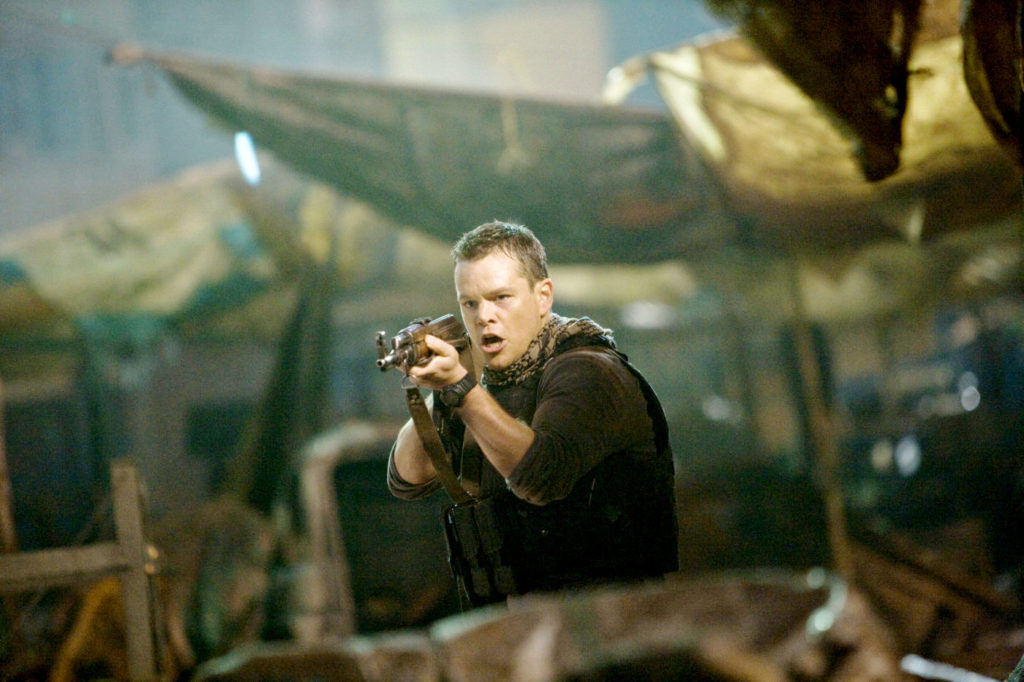
It’s March 2003. American forces occupy Baghdad. And U.S. Army Chief Warrant Officer Roy Miller has a job to do: find Weapons of Mass Destruction. As Miller’s squad follows orders and clears out one treacherous site after another, it finds looters, snipers and even a warehouse of old toilets, but not a hint of WMD.
In the next intel briefing, the chief complains to his superiors that their information must be compromised. There’s something screwy going on. Outside of essentially telling him to shut up and do what he’s told, however, the brass doesn’t have much to offer.
After the briefing, the CIA station chief pulls Miller aside, hands him his card and drops some clues about broken toilets not being the only things that smell. There could be some kind of conspiracy going on that ties together an American correspondent, an Iraqi informant and the White House itself.
Miller keeps digging for WMD, but when an unexpected lead puts him on the scent of a wanted Baathist general and drops a secret-filled notebook in his lap, his world becomes even more explosive. Suddenly, everybody who’s anybody wants to shut him down. And the beleaguered soldier takes on a new job: finding out the truth.
Chief Miller is a seasoned, hard-driving military man who earnestly wants to fulfill his duty. He and his squad are presented in a positive and heroic light. Even when the chief goes “off the reservation” in his quest for clear information, the only folks who assert that he’s doing wrong are the bad guys.
After being forced to kill an armed Iraqi, Miller does his best to keep a woman and her children from having to see the body. He confronts a corrupt White House official, telling him that our actions “always matter.” He then asks, “What’s going to happen the next time we need people to trust us?”
An Iraqi citizen, nicknamed “Freddy,” gives some information to Miller and ends up becoming the chief’s interpreter. And though the man’s motives are called into question and he displays anger over American arrogance, Freddy makes it clear that he’s trying to help and do the right thing for his beloved country. He is also a war hero, having lost his leg in the Iraqi/Iranian war.
CIA station chief Martin Brown is also presented as a man wanting to do what’s right. He’s a seedy character who is actively working against stated “American interests,” but he’s doing it because he truly believes a sordid conspiracy has shaped those interests, and he thinks his dangerous choices could save a great many lives.
Women in bikinis lounge around a poolside.
This is a war zone movie with quite a bit of death and destruction mixed in amongst the unraveling conspiracy. Soldiers riddle a building with bullets to take out enemy snipers. Miller exchanges gunfire with Baathist thugs—one is killed and his blood smears down the wall behind him. A U.S. helicopter is hit with a ground-to-air missile that sends the aircraft and its crew spiraling down in a ball of flames. A night battle features armed men firing automatic weapons, with multiple victims falling in sprays of blood.
Most of the more up-close and visceral violence, however, takes place off the (technical) battlefield. A Special Forces officer wants information from an Iraqi civilian and tortures the man in a back room to get what he wants. We see the questioner grab the guy by the throat—choking him and crushing his windpipe. And it’s implied that much bloodier things than that are being done. We see the battered victim later—with his face and chest covered in blood. He dies from his wounds.
The American conspiracy leaders hire masked Iraqi killers to go house to house hunting down a target. We see them killing men, execution style, with a bullet to the forehead. A battle between Baathists and Americans catches a group of women and children in the crossfire. As men plow through the screaming group, several women are sent flying and at least one appears to be shot.
Miller gets into a wrestling and pummeling tussle with a Special Forces officer who punches the chief in the face rather than take the time to talk the situation out. Miller is also shot at and then battered in the face by a rifle butt when he’s grabbed by Baathist gunmen.
Around 60 f-words and 15 s-words shoot up the script. There are two or three uses each of “b‑‑ch,” “a‑‑” and “h‑‑‑,” along with a half dozen-plus misuses of God’s and Jesus’ names. (God’s is combined with “d‑‑n” on three occasions). Two vulgar references are made to male genitalia.
A room full of Baathist party bosses smoke cigarettes. Other Iraqis smoke from time to time. Americans drink beer while lounging around a pool.
An American journalist prints stories given to her by a White House source even though she suspects they’re probably false. (And they are.)
When director Paul Greengrass and star Matt Damon (well-known for their collaborations on the spy actioners The Bourne Supremacy and The Bourne Ultimatum) were first reported to be working together on a new Iraq War film, fans immediately began referring to the pic as “Jason Bourne goes to Baghdad.” And now that Green Zone has finally exploded on the big screen, that early assessment proves pretty accurate.
Greengrass has indeed brought all his high-octane, shaky camera, duck-and-run action movie skills to bear. And Damon’s Chief Miller delivers a sizable helping of Bourne-like military rough-and-tumble—though here he has a squad of soldiers to support him in all the f-bomb lobbing, the fireball demolitions and the rapid-fire kills.
But this is not The Bourne Machination, just another chapter in the cat-and-mouse mayhem of those movies. This film has a whole lot more to say—about warfare and about the White House—than those do. You might even say it’s conspicuously professorial.
“I wanted to do a film about 9/11 and I wanted to do a film about Iraq because they seemed to me to be the two things that were driving our world,” Greengrass said about his work on the United 93 and now Green Zone in a film4.com interview. “Those were the events that were driving fear, paranoia and mistrust.”
Thus, fictional parallels relate directly to real-world people and events. And we’re repeatedly urged to take note of the “fact” that this fabricated tale isn’t actually fabricated. Definition: A corrupt government collusion was in play during the early 2000s to embrace an evident lie, and an aggressive imperialist America was on the verge of Middle East domination.
America is obviously the bad penny here, as evidenced by a smarmy Iraqi who declares that he told U.S. officials there were no WMD, but the American government “wanted to hear a lie.” Miller, for his part, is surprised that American forces are working against each other, exclaiming, “I thought we were all on the same side.” CIA agent Brown retorts, “Don’t be naive.”
This is nothing new, really. Hollywood periodically takes stabs at shaping and reshaping our perceptions of the historical record, especially when it comes to war. Our nation’s romantic memories of World War II and troubled malaise regarding the Vietnam conflict have been hugely influenced by movies. Now Green Zone joins in with a cinematic “history” lecture—undercover as a war thriller complete with eardrum-burning language and blood-spraying headshots.


After spending more than two decades touring, directing, writing and producing for Christian theater and radio (most recently for Adventures in Odyssey, which he still contributes to), Bob joined the Plugged In staff to help us focus more heavily on video games. He is also one of our primary movie reviewers.
Our weekly newsletter will keep you in the loop on the biggest things happening in entertainment and technology. Sign up today, and we’ll send you a chapter from the new Plugged In book, Becoming a Screen-Savvy Family, that focuses on how to implement a “screentime reset” in your family!